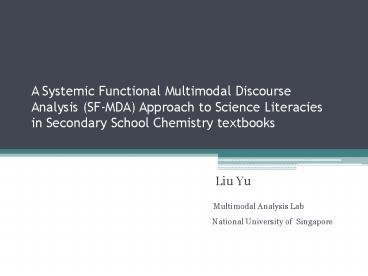A Systemic Functional Multimodal Discourse Analysis SFMDA Approach to Science Literacies in Secondar PowerPoint PPT Presentation
1 / 22
Title: A Systemic Functional Multimodal Discourse Analysis SFMDA Approach to Science Literacies in Secondar
1
A Systemic Functional Multimodal Discourse
Analysis (SF-MDA) Approach to Science Literacies
in Secondary School Chemistry textbooks
- Liu Yu
-
Multimodal Analysis Lab - National University
of Singapore
2
Background Significance of science education
- Highly valued in the school curriculum (Ministry
of Education, 2007) - Governments generous financial investment on
science education (Rose, 1997 3)
3
Scientific Literacy vs. Science Literacy
- Scientific Literacy Students individual
cognitive development and the ability to
understand scientific concepts. - Science Literacy Scientific talking, reading and
writing as representations. -
(Bennett 2003 148)
4
Literacy challenges posed by multimodal
construction of scientific knowledge
- Language
- Images
- Graphs and tables
- Mathematical symbols
- Chemical symbols
5
Research questions
- How to bridge scientific literacy and science
literacy and incorporate their insights in
chemistry education? - Why did modern chemical symbolism emerge
complementary to language? - What are the special functions of chemical
symbolism and their implications for teaching and
learning?
6
Outline
- Revisiting a classic psychological model in
chemistry education (Johnstone 1982, 1993) and
incorporating its insights into the SF-MDA
approach (OHalloran 2007) - Investigating semogenesis of modern chemical
symbolism and analyzing its functional
affordances - Discussing teaching and learning implications
from Bernsteins (1990) sociology of education
7
Scientific literacy The psychological approach
- Macroscopic
Level - Submicroscopic Level
Representational Level -
Adapted from Johnstone (1993 703)
8
Different descriptions of the rusting of iron
Adapted from Chittleborough (2004 22)
9
Science literacy Social semiotic approach
Based on Martin (2007 34)
10
Systemic functional linguistic approach to
chemistry verbal texts
11
Recent research on Multimodal Discourse Analysis
from Systemic Functional perspectives (SF-MDA)
- Displayed art (OToole 1994)
- Visual design (Kress and van Leeuwen 1996)
- Scientific and mathematical visuals (OHalloran
1996, 1999a, 2000, 2005, 2007b Baldry and
Thibault 2006 Guo 2004 Jones 2007) - Mathematical symbolism (OHalloran 1996, 1999a,
2000, 2005) - Three-dimensional objects (OToole 1994, 2004
Kress and van Leeuwen 2006) - Embodied action (Martinec 1998, 2000)
- Music (Van Leeuwen 1999)
12
SF-MDA approach to science literacies in
secondary school chemistry textbooks
13
Semogenesis of modern chemical symbolism
- Quantification requirements of chemistry
- Theoretical revolution of chemistry in the late
18th century - Meaning making potentials (language vs.
symbolism) - Ratio rate between elements (e.g. calcium
chloride / CaCl2) - Medium in an Ergativity configuration
- e.g. Charcoal is burned. / C O2
14
Lexicogrammatical strategies The Reactive
process
- The Reactive process
- C O2 CO2
- Fe O2 Fe2O3
- The Reactive/Operative process
- 2Fe 3O2 2Fe2O3
15
Lexicogrammatical strategies Multiple rankshift
- Clause 2H2 O2 ? 2H2O
- Expression H2, O2, H2O, 2H2, 2H2O (i.e. word
group - /phrase)
- Atom H, O, 2, , ? (i.e. word)
- 2H2 O2 ? 2H2O
16
Lexicogrammatical strategies Multiple rankshift
17
Lexicogrammatical strategies Multiple rankshift
- Step 1 Write the formula H2 O2
? H2O - Step 2 Count the atoms 2 2
2 1 - Step 3 Add 2 in front of H2O H2 O2 ?
2H2O - Step 4 Count the atoms again 2 2
4 2 - Step 5 Add 2 in front of H2 2H2 O2
? 2H2O - Adapted from (Onn, Ang and Khoo 2006 59)
18
Lexicogrammatical strategies Ellipsis of the
Reactive/Operative process at the rank of
Expression
- Symbolic representations of copper oxide
- Congruent representation Cu O (Berzelius
1813, see Brock 1993 154) - Rank-shifted representation CuO
19
The semo-genetic codification of copper oxide
Copper Oxide
- Cu
O
CuO
20
Viewed from Bernsteins (1990) classification of
pedagogical devices
-
Intra-individual - Psychological approach
- (e.g. Johnstone 1982, 1993)
- Acquisition
Transmission -
SF-MDA approach
-
(e.g. OHalloran 2007 ) -
-
Inter-group
21
Concluding remarks
- Developing scientific literacy with science
literacies - Chemical symbolism as powerful meaning potential
- for semantic expansions rather than a jargon
- Towards a SF-MDA meta-language for
- developing literacies with a visible pedagogy
22
Thank you!

